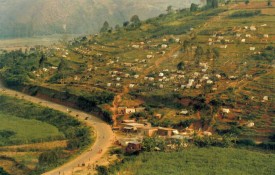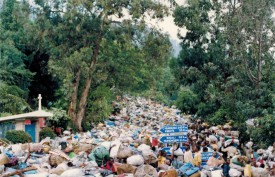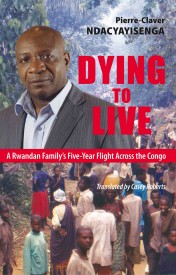A Case of Military and Economic Sabotage
By Dan Glazebrook (first published in Counterpunch, March 21-23, 2014)
Everybody knows what happened in Rwanda in 1994, right?
A bloodthirsty Hutu government set about implementing a murderous plan to eliminate the country’s Tutsi minority, using a plane crash in which the Hutu president was killed as a pretext, and killing almost a million innocent Tutsis before the heroic Rwandan Patriotic Front led by Paul Kagame managed to seize power and put an end to the genocide.
Such is the conventional narrative. It is so well known that the mere mention of the single word ‘Rwanda’ is enough to bring to mind the whole tragic story, along with its inevitable corollary – the message that the ‘international community’ (that is to say, Britain and America’s armed forces) should have invaded the country in order to prevent the government from carrying out its evil plan. Indeed, every subsequent invasion by those armies has been justified at some point in terms of the need to prevent ‘another Rwanda’. This is why it is so important that the truth about the Rwandan tragedy is better understood – and Robin Philpot’s book, Rwanda and the New Scramble for Africa, makes an extremely valuable contribution to this process.
Philpot begins by highlighting crucial details that are missed from the conventional Western narrative about Rwanda, in particular the 1990 invasion of the country by a section of the Ugandan armed forces. Back in the early 1960s, newly independent Rwanda began a thoroughgoing process of social reform. Universal suffrage meant that the majority Hutu population were able to elect a government that would tackle the centuries-old privileges of the Tutsi minority through a far-reaching programme of land redistribution on the one hand, and a state-led process of job creation and education on the other. Those Tutsi elites who could not accept equality with the Hutus went into exile, mostly in Uganda, and began to organise militias for the retaking of power from the Hutu government, organising no less than seven separate invasions of the country over the years that followed. 1990 saw the eighth. Since coming to power in 1986, Ugandan present Museveni had integrated these militias into his army, and even made one of their leaders, Paul Kagame, his chief of intelligence. It was this section of the Ugandan army that invaded Rwanda in October 1990, under the banner of the ‘Rwandan Patriotic Front’ (RPF), led by none other than Kagame himself. Museveni denied all knowledge of any invasion plans, but refused to discipline those responsible and continued to allow his country to be used a staging post for further attacks by his former troops. As the attacks continued civilians fled and by 1992, only 1800 people remained in an area of Northern Rwanda that

“within three years the number of internal refugees fleeing the RPF’s attacks had reached over one million – around 1/7 of the country’s total population”
had previously been home to 800,000; within three years the number of internal refugees fleeing the RPF’s attacks had reached over one million – around 1/7 of the country’s total population. As the country’s agricultural minister later noted, “A prefecture that had been the country’s breadbasket now had the largest population in need of welfare and the highest mortality rate due to malnutrition”. All this obviously put an immense strain on the country’s resources and created widespread tension and fear, as well as leading to the collapsing authority of the state. It is this collapse in state authority which would prove fatal when the country collapsed in 1994. But the invasion has simply been whitewashed out of the conventional narrative, and largely been relegated to a minor footnote even in more detailed accounts.
At the same time as the country was reeling from the impact of the RPF invasion, Rwanda was also subjected to economic emasculation in the guise of one of the IMF’s infamous ‘Structural Adjustment Programmes’. These programmes essentially forced third world countries to massively cut public spending and sell off as much social infrastructure as possible to the private sector. Not only did this end government support for poor farmers and reduce educational opportunities, as such programmes do everywhere, but in a country like Rwanda, where the private sector was still largely in the hands of one ethnic group (Tutsis) whilst the other (Hutus) were more likely to be reliant on public sector employment, it also deepened ethnic divisions, increasing the economic power of the Tutsis whilst impoverishing Hutus.
This combination of military and economic sabotage fatally weakened the Rwandan government, until eventually the RPF felt strong enough to break the 1993 ceasefire agreement and launch a decisive offensive in 1994, starting with the assassination of Rwandan president Habyarimana (which was almost certainly carried out by the RPF) on April 6th.
In the face of the near total collapse of state authority, and the renewal of a full scale RPF offensive, the government were unable to prevent the ensuing violence from spiralling into outright massacres, producing the 1994 tragedy in which almost a million Rwandans lost their lives. Desperate attempts by the Rwandan government to persuade the UNSC to send a peacekeeping force were wilfully sabotaged by Britain and the US, who wanted nothing to get in the way of a decisive RPF victory.
In other words, the 1994 tragedy was not the single-minded implementation of a planned genocide by an all-powerful government, but precisely the opposite – the result of a total collapse of government control of the country, as a result of years of US/UK-sponsored military and economic sabotage.
Western attempts to control the narrative of the Rwandan tragedy have been extensive. Key to the mythology of the orchestrated government genocide was the idea that the April 6th 1994 plane crash was either arranged by members of the Rwandan government itself, or was a tragic accident seized on by that government as a pretext to begin their pre-planned massacres. The suggestion, therefore, that the crash was in fact an assassination by the RPF, the opening volley in a renewed offensive aimed at destroying the fragile peace and conquering Rwanda, has been heavily repressed. From the start, detailed investigations by academics and journalists have indeed concluded that the RPF were very likely to have been behind the April 6th assassination of Presidents Habyarimana and Ntarymira. Indeed, the International Criminal Tribunal for Rwanda’s own inquiry into the assassination reached the same conclusion in 1997, but was closed down by chief prosecutor Louise Arbour (who then imposed a gagging order on its author) a few days after being summoned to a meeting with US Secretary of State Madeline Albright. The seven year long investigation by French judge Jean-Louis Bruguiere, which again implicated the RPF and Paul Kagame in the assassinations, met a similar fate, buried this time by successive French governments eager to restore good relations with the US. Since coming to power, Kagame himself has been implicated in a string of killings against former colleagues likely to be possession of information damaging to him, most recently that of former head of Rwandan intelligence Patrick Karegaya in a hotel in South Africa in January 2014.
Philpot also discusses how the neglect of crucial political and economic context in most Western accounts of the Rwandan tragedy feed into (and feed from) a centuries-old racist narrative which sees Africans as somehow simply bloodthirsty, and devoid of actual history as such. He writes that “unlike historical accounts of the bloody wars that tore Europe apart, none of the [Western] accounts of similar battles in Africa offers the least social, economic, political or institutional explanation.” As far as they are concerned, “Africans simply like to kill.” Philpot dissects in detail how European stereotypes of Africa are repeated in four of the main European/ American accounts of the Rwandan tragedy. Deeply influenced and shaped by such colonial stereotypes, from the constant contrasting of heroic civilised Europeans with hate-filled Africans (their eyes always bloodshot, of course), to the use of the ‘beautiful African countryside’ as a counter-point to its venal inhabitants, Europeans believe simplistic explanations about the Rwandan tragedy because it resonates so clearly with what they have been told about Africa for generations: that African wars are the result of little more than deeply ingrained ethnic bloodlust.
Another reason for the Western public’s willingness to believe simplified, stereotyped accounts of the causes of the 1994 tragedy, Philpot notes, has been the complicity of NGOs. He closely examines how the various Western NGOs in Rwanda in the 1990s were effectively co-opted as cheerleaders for the RPF’s war of aggression against the country, whitewashing or downplaying the crimes of the RPF, whilst exaggerating the crimes and misconstruing the motives of the Rwandan government. Human Rights Watch, for example, portrayed the arrest of suspected RPF supporters in the wake of the 1990 invasion, as a horrific human rights abuse (and, later, as early proof of their genocidal intent) – despite the fact that all were released within six months – whilst not only overlooking the context of national emergency, but even refusing to condemn the invasion itself.
Despite highlighting some gaping omissions in the conventional narrative, however, Philpot himself also neglects some important elements of the contextual background necessary for a full understanding of how and why the tragedy occurred. Perhaps in an eagerness to highlight the destabilising impact of the RPF invasion, Philpot does not discuss the deep economic problems facing the country from before 1990 and specifically, the torpedoing of a long held international agreement of coffee prices by a cartel of Western buyers in 1989 which plunged millions of Rwandan farmers into poverty. Being so overwhelmingly dependent on coffee exports, the collapse of the price of coffee effectively pushed huge swathes of the country below subsistence, meaning that even before the RPF invasion of 1990, small farmers were faced with the need to expand their acreage simply to survive. The seed may have already been planted for a civil war over the land.
I would also offer one final word of caution in regards to the book’s analysis, in the light of the ever-shifting strategic designs of Anglo-American imperialism on the African continent (and, indeed, on every continent). With Rwanda currently moving away from the West and towards China, in terms of both economy and diplomacy, it will be no surprise if we see the Western media correspondingly turning 180 degrees away from its historic whitewashing of Kagame and the RPF, and instead attempting to isolate, belittle and demonise the Rwandan state. And the last place genuine anti-imperialists would want to be is spearheading such a demonization campaign. This is not an argument to suppress the truth about the RPF’s role in destabilising Rwanda, but a call for vigilance against allowing this truth being used as a means of destabilising Rwanda once again, this time using anti-RPF forces rather than the RPF itself.
All that said, Rwanda and the New Scramble for Africa is an essential read for anyone interested in understanding the roots of the Rwandan tragedy – which are to be found not so much in ingrained ethnic hatred, as in the West’s determination to propel a sectarian client movement to power through the gradual destruction of state authority, at any cost. It is not the first time this has happened, and it will not be the last. This is the real lesson of the Rwandan tragedy.
Dan Glazebrook is a political journalist and author of Divide and Ruin: The West’s Imperial Strategy in an Age of Crisis


 Buy the book
Buy the book 

Facebook